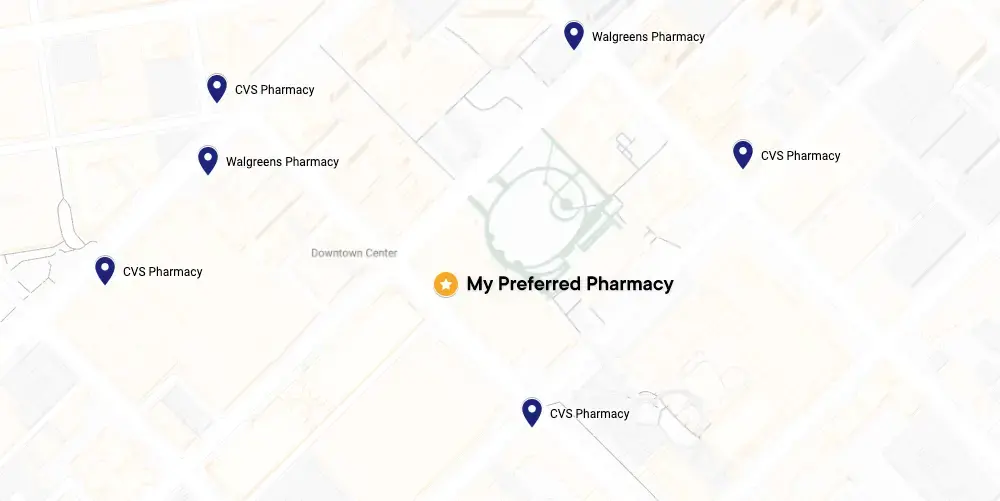Influenza is caused by the influenza virus.
The flu can easily spread from person to person, i.e. contagious, via close contact. When an infected person coughs or sneezes, droplets that contain the viruses become airborne and can be inhaled by another person in the nearby vicinity. Another method of viral spread is through touch. Either through direct touch by an infected person or indirectly touching a common surface that has been touched by an infected person, then touching your own eyes, nose or mouth.
Flu season is the time of the year when seasonal influenza outbreaks are prevalent. According to the Centers for Disease Control and Prevention, in the United States, flu season occurs typically October through March, with peak seasonal flu activity peaking between December and February.

Flu treatment available online today
In order to treat Influenza, more commonly known as the flu, consult with one of our board-certified primary care doctors today to discuss antiviral medication and other treatments to reduce aches, coughing, and fever. Get a new prescription to treat the flu today,- if safe to do so as determined by our online doctors.*
*Prescriptions are provided at the doctor's discretion. Learn more about our controlled substances policy and how to save up to 80% with our prescription discount card. PlushCare doctors cannot treat all cases of influenza. Our board certified primary care physicians can conduct an initial evaluation of your symptoms but may need to refer you to a specialist or for in-person treatment. If you are experiencing life-threatening symptoms, seek emergency medical attention immediately.
Learn about the flu
Influenza (the flu) is a highly contagious viral infection that affects the lungs, nose, and throat (respiratory tract). According to the National Foundation for Infectious Disease, millions of Americans get sick from the flu each year. During the 2022-2023 season in the US an estimated 31 million people got sick with the flu, resulting in 14 million medical visits, 360,000 hospitalizations, and 21,000 flu-related deaths.
Types of influenza viruses:
-
Influenza A
-
Influenza B
Flu symptoms tend to be more severe than the common colds. With the flu, you are likely to experience severe body aches andpains, headaches, painful throat, deep cough, fever and chills. Flu can also lead to serious complications such as pneumonia. People who are at high risk of serious flu complications include young children, older adults, pregnant women and people with specific health conditions. The National Institute on Aging also classifies seniors living in nursing homes or long-term care facilities as those with higher risk for flu and complications.
If you are sick with the flu, it is important to stay home and away from others except when seeking medical care. Contact your healthcare provider about flu treatment options. Read on to learn more about flu and also how flu is different from COVID-19.
Flu causes
Flu symptoms
According to the National Foundation for Infectious Disease, the sudden onset of the flu may include some or all of the following symptoms (think F.A.C.T.S.):
-
Aches (muscle, body, and headaches)
-
Chills
-
Tiredness (fatigue)
-
Sudden onset
-
Nasal discharge
-
Stuffy nose
*Disclaimer: You should seek emergency attention immediately if you are experiencing severe or life-threatening symptoms such as shortness of breath, high fever that does not come down with fever-reducing medicine and fluids, or persistent chest pain. If you are at high risk of flu complications, see a doctor right away to discuss strategies to prevent serious flu complications.
How to treat the flu
Your immune system is the number one tool to treat the flu. The best way to boost your immune system when you’re sick is to get as much rest and fluids as possible. This helps the body fight off the influenza virus. Over the counter medications such as Tylenol (acetaminophen) and Advil/Motrin (ibuprofen) can help reduce fever and body aches. Aspirin plays a limited role in managing flu symptoms and should never be given to children five years of age or younger.
Talk to your online primary care doctor while you are sick to request a work or school excuse note so that you can get the rest you need. Our doctors cannot provide notes if you are seen only after your illness has improved, so please schedule your visit while you are sick and need to stay home.
There are also FDA approved antiviral drugs that can be prescribed to help treat the flu. Speak with your doctor to learn about antiviral medication options.
Flu medication
Flu antiviral drugs
Flu antiviral drugs can be prescribed as treatment for the flu. When taken within 48 hours after flu symptoms begin, flu antiviral drugs can help reduce the length and severity of symptoms. In certain situations, starting antiviral treatment more than 48 hours from onset of symptoms is also advised, especially for people who might spread their infection to other people at risk of severe complications from influenza. Below is a list of prescription antiviral medications that can be discussed with one of our online primary care physicians:
Typically, flu goes away on its own in 3 to 10 days. For healthy people, adequate rest and fluid intake is enough to help the body's immune system fight off the influenza virus. Antiviral treatment is not necessary for everyone.
Over the counter medicines and home remedies
Over-the-counter medicines, such as acetaminophen or ibuprofen, can help reduce fever, headache, sore throat and body pains. Aside from these medicines, here are some at home remedies that may also help you feel better:
- Stay home and get as much rest as possible – not only does this fuel your immune system, but it reduces your risk of spreading the infection to others
- Drink plenty of warm liquids - chicken or vegetable soup, warm water with lemon, hot tea with honey
- Saltwater gargle - can help reduce swelling and sooth sore throat
- Saline nasal irrigation - can help with runny and stuffy nose
How to prevent the flu
The influenza vaccination (flu shot) is a critical tool in flu prevention. The Centers for Disease Control and Prevention (CDC) recommends that everyone age 6 months and older get vaccinated annually. Flu vaccines are not the same each year. They are updated annually to protect against possible new strains of flu viruses. According to the Centers for Disease Control and Prevention, the flu is one of the more contagious infectious diseases. Another key idea behind flu prevention is to prevent the spread of the influenza viruses through good hygiene practices:
-
Wash hands frequently with soap
-
Cover mouth and nose when sneezing or coughing
-
Disinfecting commonly touched surfaces frequently
-
Stay at home if you are sick with influenza symptoms, and wear a mask if you have to be around others or go for in person medical care
In addition, stay healthy and keep your immune system up to be able to fend off the flu virus:
-
Exercise
-
Get enough sleep
-
Stay hydrated
-
Eat whole foods including fruits and vegetables every day
When to see a doctor for the flu
Seek medical attention for the flu if you belong to the following groups of people who are at higher risk of serious flu complications:
-
Young children especially under the age of 2 years
-
Older adults 65 years and above
-
Pregnant women or women who have given birth within the past 2 weeks
-
People with serious underlying health conditions such as diabetes, asthma or other lung disease, heart disease, neurologic disorders, chronic kidney or liver disease, or a compromised immune system.
-
Non-Hispanic Black persons, Hispanic or Latino persons, and American Indian or Alaska Native persons
Seek emergency care for prompt treatment if you have suspected flu symptoms and the following emergency signs:
-
Difficulty breathing
-
High fever that does not come down with fever medicine
-
Seizures
-
Dizziness
-
Chest pain
-
Severe muscle aches
For children, the emergency symptoms (in addition to flu symptoms):
-
Difficulty breathing or grunting while breathing
-
Fever that does not improve with fever reducing medicine (never give aspirin to a child)
-
Seizures
-
Chest pain
-
Severe muscle aches
-
Dehydration or difficulty tolerating fluids
-
Blue lips or pale to blue skin
Flu treatment FAQs
What is the best treatment for the flu?
The best treatment for flu treatment primarily includes resting and drinking enough fluids to let the body's immune system fight off the influenza virus. Over the counter acetaminophen and ibuprofen can help reduce fever and body pains.
What cures the flu quickly?
Typically, flu goes away on its own in 3 to 10 days with adequate rest and fluid intake. There are also flu antiviral drugs that can be prescribed to treat flu. When taken within 48 hours of the first signs of the flu, antiviral drugs can help reduce length of illness by up to 24 hours.
How long does a flu last?
Typically, flu goes away on its own in 3 to 10 days with adequate rest and fluid intake.
What will the doctor do for the flu?
Doctors can prescribe flu antiviral drugs when appropriate. When taken within 48 hours after flu symptoms begin, antiviral drugs can help reduce the length of illness by up to one day and can reduce the risk of spreading the infection to others. But note that in healthy people, flu goes away on its own in 3 to 10 days with adequate rest and fluid intake.
How can I relieve flu symptoms at home?
To relieve flu symptoms at home, over-the-counter medicines, such as acetaminophen or ibuprofen, can help reduce fever and body aches. Aside from over-the-counter medicines, here are some at home remedies that may also help you feel better:
-
Get adequate rest
-
Warm liquids: Chicken or vegetable soup, warm water with lemon, hot tea
-
Saltwater gargle can help reduce swelling and sooth sore throat
-
Saline nasal irrigation can help with runny and stuffy nose
What over the counter flu medications can I use?
While over-the-counter (OTC) medications like pain and fever relievers and cough suppressants can help relieve flu symptoms, they won't shorten the illness or address the underlying infection. A doctor can diagnose the flu, prescribe antiviral medications that can shorten your illness by up to one day and reduce the risk of severe complications or spread to others, and recommend additional strategies to manage your condition. Here's why a doctor's visit is important:
Antiviral medications: Seeing a doctor within 48 hours of the onset of flu symptoms allows them to prescribe antiviral medications, when appropriate. These can shorten your illness by up to one day, may possibly lessen symptom severity, reduce the risk of infection spread to others, and reduce the risk of complications like pneumonia.
Diagnosis: A doctor can help you differentiate the flu from other illnesses and provide personalized guidance on managing your symptoms. This might include specific rest recommendations, hydration advice, and strategies to prevent the spreading of the flu.
Identifying potential complications: In some cases, the flu can lead to more serious complications like pneumonia. A doctor can help identify these early and ensure you receive proper treatment.
Seeing a doctor online is fast and convenient. Our board-certified primary care physicians are available 24/7 for telehealth consultations. You can get a diagnosis, discuss treatment options (including antiviral medications if appropriate), and receive a prescription sent directly to your pharmacy – all from the comfort of your home.
3 simple steps to request treatment for the flu today

Book a flu treatment appointment.

Talk to your medical provider regarding your flu symptoms.

Pick up a prescription to treat the flu, if recommended by your doctor.
Related conditions to the flu
Cold
While the common cold is different from the flu, it is sometimes hard to tell which one you have because common colds have several flu-like symptoms (e.g. cough, nasal congestion, nasal discharge). More than 200 viruses are known to cause the common cold. However, amongst them, rhinoviruses are the most prevalent. The cold and flu are both considered upper respiratory tract infections, but flu symptoms tend to be more severe than the common cold and also tend to hit harder and faster than the common cold.
COVID-19
COVID-19 is caused by the virus SARS-CoV-2 while the flu is caused by the influenza virus. According to the Centers for Disease Control and Prevention, COVID-19 spreads more easily than flu and can cause more serious illnesses in some people.
It is hard to distinguish the flu from COVID-19 just by looking at the symptoms alone as they share many similar symptoms. That is why a COVID-19 test is needed in order to confirm diagnosis. These symptoms are characteristic of COVID-19:
-
Severe aches, pains
-
Headaches
-
Fever or chills
-
New loss of taste or smell
-
Diarrhea
-
Fatigue
-
Throat pain
-
Sinus or nasal congestion
Pneumonia
Pneumonia is a serious lung disease. Viral or bacterial infections can cause inflammation of the lungs, preventing proper oxygenation of the lungs, and depriving the body of oxygen which can lead to death. Flu is a common cause of pneumonia.
Bronchitis
Bronchitis is the inflammation of the bronchial tubes, which are part of your lower respiratory tract, and carry air to and from the lungs. Acute bronchitis is a short-term condition and can be caused by an infection or irritating substance, such as inhaled smoke. Common cold viruses are a very frequent cause of acute bronchitis, and only occasionally are antibiotics needed for the treatment of bronchitis. Chronic bronchitis lasts at least three months and has many different causes.
Sinus infection
Sinus infection (sinusitis) is one of the common ways that an upper respiratory infection can present itself. There are two types of sinusitis: viral and bacterial sinusitis. During the flu, the virus can infect the sinuses and cause inflammation in the sinus membranes - viral sinusitis. Many other common cold viruses can also cause sinusitis. When sinusitis is caused by bacterial infection, it is known as bacterial sinusitis. Symptoms that are common between the flu and sinus infection are: runny nose, stuffy nose, post-nasal drip and cough.
Flu treatment pricing details
To request flu treatment and get a new prescription, join our monthly membership and get discounted visits.
30 days of free membership
- Same-day appointments 7 days a week
- Unlimited messages with your Care Team
- Prescription discount card to save up to 80%
- Exclusive discounts on lab tests
- Free memberships for your family
- Cancel anytime
Paying with insurance
Membership
$19.99
First month free
Visits
Copay
Visit price with insurance
Often the same as an office visit. Most patients with in-network insurance pay $30 or less!
We accept these insurance plans and many more:



Paying without insurance
Membership
$19.99
First month free
Visits
$129
Visit price without insurance
Flu treatment resources
Sources:
PlushCare is dedicated to providing you with accurate and trustworthy health information.
-
Mayo Clinic. "Flu (Influenza) - Symptoms and Causes." Accessed 2 Oct. 2023, https://www.mayoclinic.org/diseases-conditions/flu/symptoms-causes/syc-20351719
-
Centers for Disease Control and Prevention (CDC). "About Flu - Seasonal Influenza (Flu)." Accessed 2 Oct. 2023, https://www.cdc.gov/flu/about/index.html
-
National Institute of Allergy and Infectious Diseases (NIAID). "Influenza (Flu) Treatment." Accessed 2 Oct. 2023, https://www.niaid.nih.gov/diseases-conditions/influenza-treatment
-
Centers for Disease Control and Prevention (CDC). "Flu Symptoms & Complications." Accessed 2 Oct. 2023, https://www.cdc.gov/flu/symptoms/flu-vs-covid19.htm
-
National Institute on Aging (NIA). "Flu and Older Adults." Accessed 2 Oct. 2023, https://www.nia.nih.gov/health/flu/flu-and-older-adults
PlushCare content is reviewed by MDs, PhDs, NPs, nutritionists, and other healthcare professionals. Learn more about our editorial standards and meet the medical team. The PlushCare site or any linked materials are not intended and should not be construed as medical advice, nor is the information a substitute for professional medical expertise or treatment.